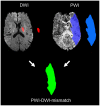Wake-up stroke: clinical characteristics, imaging findings, and treatment option - an update
- PMID: 24723908
- PMCID: PMC3972483
- DOI: 10.3389/fneur.2014.00035
Wake-up stroke: clinical characteristics, imaging findings, and treatment option - an update
Abstract
About 25% of all strokes occur during sleep, i.e., without knowledge of exact time of symptom onset. According to licensing criteria, this large group of patients is excluded from treatment with received tissue-plasminogen activator, the only specific stroke treatment proven effective in large randomized trials. This paper reviews clinical and imaging characteristics of wake-up stroke and gives an update on treatment options for these patients. From clinical and imaging studies, there is evidence suggesting that many wake-up strokes occur close to awakening and thus, patients might be within the approved time-window of thrombolysis when presenting to the emergency department. Several imaging approaches are suggested to identify wake-up stroke patients likely to benefit from thrombolysis, including non-contrast CT, CT-perfusion, penumbral MRI, and the recent concept of diffusion weighted imaging-fluid attenuated inversion recovery (DWI-FLAIR). A number of small case series and observational studies report results of thrombolysis in wake-up stroke, and no safety concerns have occurred, while conclusions on efficacy cannot be drawn from these studies. To this end, there are ongoing clinical trials enrolling wake-up stroke patients based on imaging findings, i.e., the DWI-FLAIR-mismatch (WAKE-UP) or penumbral imaging (EXTEND). The results of these trials will provide evidence to guide thrombolysis in wake-up stroke and thus, expand treatment options for this large group of stroke patients.
Keywords: DWI-FLAIR-mismatch; acute ischemic stroke; computed tomography; fluid attenuated reversion recovery; magnetic resonance imaging; thrombolysis; wake-up stroke.
Figures


Similar articles
-
A multicenter, randomized, double-blind, placebo-controlled trial to test efficacy and safety of magnetic resonance imaging-based thrombolysis in wake-up stroke (WAKE-UP).Int J Stroke. 2014 Aug;9(6):829-36. doi: 10.1111/ijs.12011. Epub 2013 Mar 12. Int J Stroke. 2014. PMID: 23490032 Clinical Trial.
-
Are the current MRI criteria using the DWI-FLAIR mismatch concept for selection of patients with wake-up stroke to thrombolysis excluding too many patients?Scand J Trauma Resusc Emerg Med. 2015 Feb 19;23:22. doi: 10.1186/s13049-015-0101-7. Scand J Trauma Resusc Emerg Med. 2015. PMID: 25888410 Free PMC article.
-
Clinical characteristics of unknown symptom onset stroke patients with and without diffusion-weighted imaging and fluid-attenuated inversion recovery mismatch.Int J Stroke. 2018 Jan;13(1):66-73. doi: 10.1177/1747493017706245. Epub 2017 Apr 20. Int J Stroke. 2018. PMID: 28425349
-
Safety and cost-effectiveness thrombolysis by diffusion-weighted imaging and fluid attenuated inversion recovery mismatch for wake-up stroke.Clin Neurol Neurosurg. 2018 Jul;170:47-52. doi: 10.1016/j.clineuro.2018.04.027. Epub 2018 Apr 23. Clin Neurol Neurosurg. 2018. PMID: 29729542 Review.
-
Acute imaging for evidence-based treatment of ischemic stroke.Curr Opin Neurol. 2019 Aug;32(4):521-529. doi: 10.1097/WCO.0000000000000716. Curr Opin Neurol. 2019. PMID: 31116116 Review.
Cited by
-
Tenecteplase for the treatment of acute ischemic stroke in the extended time window: a systematic review and meta-analysis.Ther Adv Neurol Disord. 2024 Jan 6;17:17562864231221324. doi: 10.1177/17562864231221324. eCollection 2024. Ther Adv Neurol Disord. 2024. PMID: 38193030 Free PMC article.
-
Use of DWI-FLAIR Mismatch to Estimate the Onset Time in Wake-Up Strokes.Neuropsychiatr Dis Treat. 2022 Feb 21;18:355-361. doi: 10.2147/NDT.S351943. eCollection 2022. Neuropsychiatr Dis Treat. 2022. PMID: 35228801 Free PMC article.
-
Pre-hospital stroke monitoring past, present, and future: a perspective.Front Neurol. 2024 Mar 22;15:1341170. doi: 10.3389/fneur.2024.1341170. eCollection 2024. Front Neurol. 2024. PMID: 38585364 Free PMC article.
-
Surrogate biomarkers of outcome for wake-up ischemic stroke.BMC Neurol. 2022 Jun 9;22(1):215. doi: 10.1186/s12883-022-02740-z. BMC Neurol. 2022. PMID: 35681147 Free PMC article.
-
An update on hyper-acute management of ischaemic stroke.Clin Med (Lond). 2021 May;21(3):215-221. doi: 10.7861/clinmed.2020-0998. Epub 2021 May 4. Clin Med (Lond). 2021. PMID: 33947658 Free PMC article. Review.
References
-
- Mackay J, Mensah GA. The Atlas of Heart Disease and Stroke. Geneva: World Health Organisation; (2004).
-
- Allender S, Scarborough P, Viv P, Rayner M, Leal JS, Luengo-Fernandez R, et al. European Cardiovascular Disease Statistics. 2008 ed European Heart Network (2008).
-
- Welch KMA, Tilley BC, Marler JR, Brott T, Lyden P, Grotta JC, et al. Tissue plasminogen activator for acute ischemic stroke. The National Institute of Neurological Disorders and Stroke rt-PA Stroke Study Group. N Engl J Med (1995) 333:1581–7 - PubMed
-
- Wahlgren N, Ahmed N, Dávalos A, Ford GA, Grond M, Hacke W, et al. Thrombolysis with alteplase for acute ischaemic stroke in the Safe Implementation of Thrombolysis in Stroke-Monitoring Study (SITS-MOST): an observational study. Lancet (2007) 369:275–8210.1016/S0140-6736(07)60149-4 Erratum in 826, - DOI - PubMed
Publication types
LinkOut - more resources
Full Text Sources
Other Literature Sources

